Support Government’s efforts to accelerate Papua’s development
*) By: Kayla Ananda
In recent years, the Indonesian government has stepped up its efforts to accelerate development in Papua, especially in the area of infrastructure. The move is aimed not only at improving the well-being of the Papua people, but also to strengthen the integration of Papua with other parts of Indonesia.
One of the main focus in accelerating Papua’s development is the construction of roads and bridges. According to data from the Ministry of Public Works and People’s Housing (PUPR), by the end of 2023, more than 4,000 kilometres of Papua trans roads have been built. This road connects remote areas of Papua with the city centers, facilitating access to transportation and distribution of goods and services. A real example is the construction of Papua Trans Road that connects Sorong with Merauke. The road is expected to cut travel time by up to 50%, having a positive impact on the local economy and mobility of the population.
Abdul Halim Iskandar, Minister of Rural Affairs, Development of Remaining Areas and Transmigration (Kemendesa PDTT) of RI, said Papua is a strategic region for development of a region behind because of its huge potential in natural resources and unique cultural diversity. Located on the east end of Indonesia, Papua offers great opportunities for infrastructure development that can improve connectivity and accessibility, not only for locals but also for communities who want to transmigrate. Well-planned migration programmes can help to redistribute populations, reduce regional development gaps, and open up sustainable new economic opportunities. With proper investment in infrastructure and public services, Papua can be a catalyst for accelerating the development of lagging-back areas in Indonesia.
The focus of infrastructure development is also shown in development. The Holtekamp Bridge in Jayapura, which was officially inaugurated in 2019, has become one of the infrastructure icons in Papua. This bridge not only smoothes the flow of traffic, but also symbolizes the government’s commitment to Papua’s development. With a length of about 732 meters, the bridge connects the center of Jayapura with the surrounding districts, reducing congestion and increasing transport efficiency.
Meanwhile, the development of air infrastructure is also a priority in efforts to accelerate Papua’s development. Sentani Airport in Jayapura, as one of the main gates to Papua, has undergone expansion and improvement of facilities. According to data from the Ministry of Communications, the passenger capacity at Sentani Airport has doubled after the renovation. In addition, several pioneering airports in remote areas have also been built and refurbished to improve air accessibility to hard-to-reach areas via land lines.
Central Papua Deputy Governor (PJ), Ribka Haluk said increased connectivity has brought significant change to the communities in the region. With the construction of infrastructure such as Papua Trans Road and the upgrading of Sentani Airport facilities, land and air transport access became more smooth and efficient. New bridges, such as the Holtekamp Bridge in Jayapura, also accelerate the flow of traffic and the distribution of goods and services, connecting remote areas with economic centres. In addition, the development of telecommunications infrastructure through the Palapa Ring East program has provided fast internet access in various districts/cities, opening up opportunities in the education, health, and digital economy sectors. All of this not only strengthens the integration of Papua with the rest of Indonesia, but also improves the quality of life of local people by expanding access to various services and economic opportunities.
This increased air connectivity not only facilitates public mobility, but also opens up new economic opportunities. Tourism in Papua, for example, is growing with better air access. Domestic and international tourists can now easily visit tourist destinations such as Raja Ampat and Baliem Valley, which is famous for its natural beauty and cultural wealth of Papua.
Not only physical infrastructure, the development of telecommunications infrastructure is also an important concern in the acceleration of Papua development. The Palapa Ring East program, initiated by the government, aims to provide fast internet access throughout Papua and West Papua. According to data from the Ministry of Communications and Informatics, a 4,450-kilometre-long fiber optic network has been completed, connecting more than 35 districts/cities in Papua.
This better internet access opens up new opportunities in a variety of sectors, including education, health, and the digital economy. Schools in remote areas now have access to online learning materials, improving the quality of education. Meanwhile, micro, small and medium-sized enterprises (MSMEs) in Papua can take advantage of e-commerce platforms to expand their markets.
Despite much progress, the acceleration of infrastructure development in Papua still faces challenges. Difficult geographical conditions, such as rocky mountains and dense forests, become one of the main obstacles. Besides, security aspects also need to be taken into account, given the presence of local conflicts that sometimes interfere with the development process.
However, with the commitment and cooperation between the central government, the local government, and the Papua community, these challenges are expected to be overcome. The active participation of the public in every stage of development is essential to ensure that infrastructure development really benefits them.
Accelerating infrastructure development in Papua is a strategic step towards improving the well-being of the people and strengthening regional integration. Construction of roads and bridges, improved air connectivity, as well as development of telecommunications infrastructure are the main focus of this effort. Despite the challenges, the progress that has been made shows that Papua is moving towards a better future. The support and participation of all parties is essential to realize the vision of inclusive and sustainable development in Papua.
*) The author is a contributor to Daris Library
